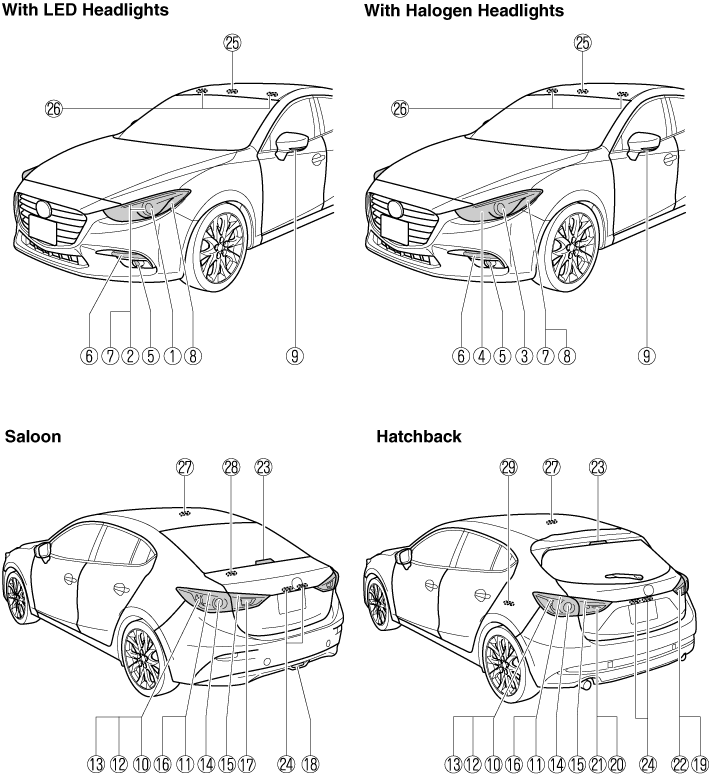Light Bulbs

 Headlights (Low/High beam)
Headlights (Low/High beam)
 Running lights
Running lights
 Headlights (Low beam)
Headlights (Low beam)
 Headlights (High beam)/Running lights (Some Models)
Headlights (High beam)/Running lights (Some Models)
 Front fog lights (Some Models)
Front fog lights (Some Models)
 Front direction indicator lights
Front direction indicator lights
 Position lights
Position lights
 Front side-marker lights (Some Models)
Front side-marker lights (Some Models)
 Side direction indicator lights
Side direction indicator lights
 Brake lights (With LED headlights)
Brake lights (With LED headlights)
 Tail lights (With LED headlights)
Tail lights (With LED headlights)
 Brake lights/Tail lights (With halogen headlights)
Brake lights/Tail lights (With halogen headlights)
 Rear side-marker lights (Bulb type) (Some Models)
Rear side-marker lights (Bulb type) (Some Models)
 Rear direction indicator lights
Rear direction indicator lights
 Tail lights (With LED headlights)
Tail lights (With LED headlights)
 Rear side-marker lights (LED type) (Some Models)
Rear side-marker lights (LED type) (Some Models)
 Reverse lights
Reverse lights
 Rear fog light (Some Models)
Rear fog light (Some Models)
 Reverse light (Left-hand drive model)
Reverse light (Left-hand drive model)
 Reverse light (Right-hand drive model)
Reverse light (Right-hand drive model)
 Rear fog light*1/Reverse light*2 (Left-hand drive model)
Rear fog light*1/Reverse light*2 (Left-hand drive model)
 Rear fog light*1/Reverse light*2 (Right-hand drive model)
Rear fog light*1/Reverse light*2 (Right-hand drive model)
 High-mount brake light
High-mount brake light
 Number plate lights
Number plate lights
 Overhead lights (Front)/Map lights (Some Models)
Overhead lights (Front)/Map lights (Some Models)
 Vanity mirror lights (Some Models)
Vanity mirror lights (Some Models)
 Overhead lights (Rear) (Some Models)
Overhead lights (Rear) (Some Models)
 Boot light (Saloon)
Boot light (Saloon)
 Luggage compartment light (Hatchback)
Luggage compartment light (Hatchback)
-
With rear fog light
-
Without rear fog light
Never touch the glass portion of a halogen bulb with your bare hands and always wear eye protection when handling or working around the bulbs:
When a halogen bulb breaks, it is dangerous. These bulbs contain pressurised gas. If one is broken, it will explode and serious injuries could be caused by the flying glass.
If the glass portion is touched with bare hands, body oil could cause the bulb to overheat and explode when lit.
Always keep halogen bulbs out of the reach of children:
Playing with a halogen bulb is dangerous. Serious injuries could be caused by dropping a halogen bulb or breaking it some other way.


When removing the lens or lamp unit using a flathead screwdriver, make sure that the flathead screwdriver does not contact the interior terminal. If the flathead screwdriver contacts the terminal, a short circuit may occur.


-
To replace the bulb, contact an expert repairer, we recommend an Authorised Mazda Repairer.
-
If the halogen bulb is accidentally touched, it should be cleaned with rubbing alcohol before being used.
-
Use the protective cover and carton for the replacement bulb to dispose of the old bulb promptly and out of the reach of children.




 Read this first
Read this first



















